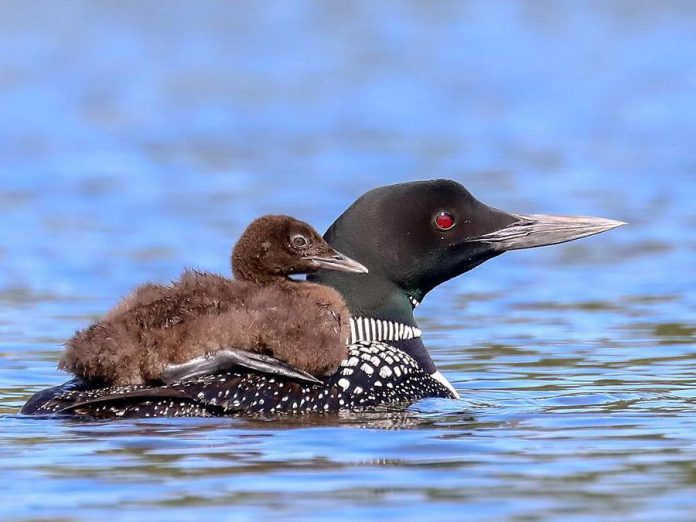
Wildlife and nature photographer Cliff Homewood has done it again: captured some amazing shots of a pair of loons raising their baby in Kawartha Lakes, which he has posted on his Instagram @kerrybrook.
Last year, we featured Cliff’s shots of a family of loons and we’re doing it again.
As we said last year, Cliff is an experienced wildlife photographer and he’s careful not to disturb the loons or their babies when taking his photos.
The common loon (Gavia immer) is close to the heart of cottagers and campers in Ontario, with the bird’s distinctive cries, wails, and yodels often echoing across lakes and rivers in the Kawarthas.
The official state bird of Minnesota since 1961, the loon was adopted in 1994 by Ontario as the province’s official bird. Every Canadian is also familiar with the loon on the “loonie”, the coin that replaced the $1 bill in 1987.
As you look at Cliff’s photos, it helps to know a bit about how loons are born and raised. After a pair of loons mate, they build their nest clost to water — on the edge a small island or a half-submerged log for example — and they’ll often use the same sites from year to year. Both the male and female help with nest building, using mud, grass, and other vegetation. The female will lay usually one or two eggs in late May or June, with the eggs incubating for almost a month.
In late June or early July, the eggs hatch and the chicks emerge, covered in brown and black down. They can swim right away, but will spend time riding on their parents’ backs to conserve energy and to avoid predators like large fish, birds, and snapping turtles. Their parents feed them minnows and insects during their first few weeks of life. After about two months, the chicks begin to dive for some of their own food. By three months, they are catching almost all of their own food and are able to fly. By early fall, the young loons are able to look after themselves completely.
Below are Cliff’s photos of the loons, from most to least recent. We’ll update this story with new photos as Cliff posts them on Instagram, or you can follow his Instagram feed yourself @kerrybrook (he shares a lot of wonderful photos of wildlife and nature). Cliff also owns and operates Kerrybrook Web Design at kerrybrookwebdesign.ca.
August 20, 2018
August 13, 2018
August 12, 2018
August 11, 2018
August 1, 2018
July 27, 2018
July 19, 2018
July 17, 2018
July 16, 2018
July 15, 2018
July 13, 2018
July 9, 2018
July 5, 2018
June 28, 2018



























